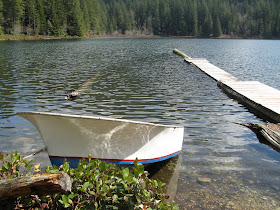 If you live in Powell River, it's likely you knew Poki. He was an avid ATV rider and trail builder, but his life was cut short by cancer. In his honour, the shelter at Giavanno Lake was christened "Poki's Place."
If you live in Powell River, it's likely you knew Poki. He was an avid ATV rider and trail builder, but his life was cut short by cancer. In his honour, the shelter at Giavanno Lake was christened "Poki's Place." Poki's Place is a frequent destination for local riders on weekends when logging roads are open to the public. That was the destination Wayne and I picked for a ride last Sunday.
Poki's Place is a frequent destination for local riders on weekends when logging roads are open to the public. That was the destination Wayne and I picked for a ride last Sunday. We drove through Cranberry and then out Duck Lake Forest Service Road. Just after the end of the pavement we found a turnout large enough for our truck and double quad trailer. The ride gave us a chance to try out the new ATV Trail Guide written by the PRATV Club President Dave Hodgins. We figured with the great maps, directions and GPS coordinates, we couldn't get too lost on our own.
We drove through Cranberry and then out Duck Lake Forest Service Road. Just after the end of the pavement we found a turnout large enough for our truck and double quad trailer. The ride gave us a chance to try out the new ATV Trail Guide written by the PRATV Club President Dave Hodgins. We figured with the great maps, directions and GPS coordinates, we couldn't get too lost on our own. From the Duck Lake Bridge we headed east on Duck Lake FSR Branch 1. At 7.1 km there is a well marked intersection that turns you left onto East Haslam Main. In another 10.1 km, you reach the intersection with Giavanno Main. From here there are two entrances to choose from, one at 2.7 km and one at 3.7 km up Giavanno Main. We chose the second with a well build quad bridge put in place by the Wednesday Trail Building Group. The trails into Poki's Place are maintained by this group of very dedicated volunteer workers.
From the Duck Lake Bridge we headed east on Duck Lake FSR Branch 1. At 7.1 km there is a well marked intersection that turns you left onto East Haslam Main. In another 10.1 km, you reach the intersection with Giavanno Main. From here there are two entrances to choose from, one at 2.7 km and one at 3.7 km up Giavanno Main. We chose the second with a well build quad bridge put in place by the Wednesday Trail Building Group. The trails into Poki's Place are maintained by this group of very dedicated volunteer workers. After a picnic lunch and a little fishing we left by the Fiddlehead Trail. This trail starts over a rustic split cedar bridge, again built by the Wednesday Group. The trail is easy to moderate, with only a few uneven and boggy spots. The ride through the trees was beautiful, and there was no dust like on the busy mains. The end of the Fiddlehead Trail junctions with the Haslam Main at the head of Haslam Lake. Turn left and follow East Haslam Main back to your starting point.
After a picnic lunch and a little fishing we left by the Fiddlehead Trail. This trail starts over a rustic split cedar bridge, again built by the Wednesday Group. The trail is easy to moderate, with only a few uneven and boggy spots. The ride through the trees was beautiful, and there was no dust like on the busy mains. The end of the Fiddlehead Trail junctions with the Haslam Main at the head of Haslam Lake. Turn left and follow East Haslam Main back to your starting point. It was good to see so many people out on a sunny weekend enjoying the roads and trails in the Powell River back country. That is one of the benefits of living here on the BC coast.
It was good to see so many people out on a sunny weekend enjoying the roads and trails in the Powell River back country. That is one of the benefits of living here on the BC coast.Would you like a book of maps for ATV trails in the Powell River area? The ATV Trail Guide will be on sale at the PRATV General Membership Meeting on May 14 at 7:00 pm in the Popular Room at the Powell River Complex. If you want to become a member, this is enrolment time. If you are already a member, we hope to see you there. -- Margy












































